Up in arms
In the fight against terrorism, the Federal Government is to be congratulated on the decision to add a new weapon to the nation’s armoury.
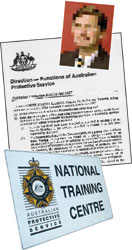 The Australian Protective Service (APS) was established in 1984 with
the Federal Minister for Justice and Customs responsible for its activities.
In 1989 the then Justice Minister Senator Michael Tate said that the APS
would take over “the counter-terrorist first response function performed
by the Australian Federal Police (AFP) at airports.” He also announced
that the Australian Protective Services Act 1987 had “been amended to
provide necessary additional powers for the APS to carry out counter-terrorist
first response functions at designated security airports from 1 January
1990.”1
The Australian Protective Service (APS) was established in 1984 with
the Federal Minister for Justice and Customs responsible for its activities.
In 1989 the then Justice Minister Senator Michael Tate said that the APS
would take over “the counter-terrorist first response function performed
by the Australian Federal Police (AFP) at airports.” He also announced
that the Australian Protective Services Act 1987 had “been amended to
provide necessary additional powers for the APS to carry out counter-terrorist
first response functions at designated security airports from 1 January
1990.”1
By 1996 the APS had the role of providing security at the following locations:
• The residences of the Governor-General and Prime Minister;
• Parliament House and the office of the Prime Minister;
• Sensitive defence establishments;
• Counter-terrorist First Response at major airports;
• Offices and residences of high office holders;
• Foreign diplomatic missions;
• The Australian Nuclear Science and Technology Organisation.2
On November 19, 2001, the Minister for Justice and Customs Senator the Hon Chris Ellison (WA) said, “The government decided to introduce armed security officers selectively on flights provided by Australian air carriers. The Australian Protective Service [is] to be charged with the responsibility of implementing the Air Security Officer (ASO) Programme by the end of the year.”3
Section 6(1) of the Australian Protective Services Act 1987 allows the Minister to determine the functions of the APS in relation to “such protective and custodial services for or on behalf of the Commonwealth as the Minister, by notice in writing published in the Gazette, directs.” Accordingly, the functions of a “uniformed security force” were redefined to accommodate the presence of armed APS staff on aircraft.
The office of the Attorney-General, in consultation with the Department of Transport and Regional Services and airlines, developed the final policies that allowed the transport of armed ASOs. Qantas airlines supplied training in aircraft emergency prodecures4 while specialist advice was received from both the Israeli Government and the Air Marshal Division of the United States Federal Aviation Administration.
Media were quick to link the role of the ASO with guns. ‘Licence to kill’ published the Herald Sun (19/12/2001) and at the same time it reported that guards will “be authorised to shoot first and ask questions later”. The article quoted a ‘senior intelligence informant’ who said, “They are authorised to use lethal force if necessary. If there is a terrorist with a machine-gun or something running towards the cockpit, there’s not going to be time to say stop.”
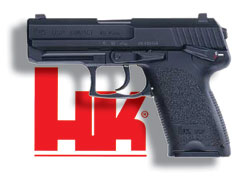
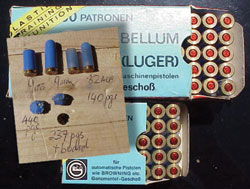
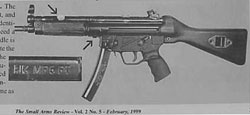
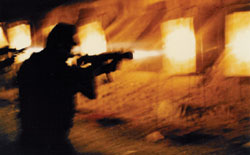
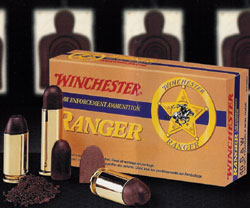
 The ‘senior intelligence informant’ forgot
to mention the metal detector at the passenger final screening point and
its capacity to alert security staff of minor metal objects, even sub-machine-guns.
The ‘senior intelligence informant’ forgot
to mention the metal detector at the passenger final screening point and
its capacity to alert security staff of minor metal objects, even sub-machine-guns.
In January 2002, The Canberra Times printed a letter to the editor, in which the author expressed his concern at having armed “sky marshals” on aircraft. He makes the comment that sky marshals “did not stop Lockerbie”. Since Pan Am Flight 103 was destroyed when a bomb exploded in the forward cargo hold, it would be obvious that in this situation an armed guard within the aircraft would have been able to do little.
There has been considerable interest in the research and development of suitable handgun/ammunition combinations for use by ASOs during the past few years. We are aware that one European country is using the SIG P232 in 380ACP calibre using conventional ammunition that will not penetrate an aircraft’s skin. Handgun tests are being conducted now by another European country using frangible ammunition reportedly developed by Dynamit Nobel.
The choice of handgun made by the APS is of interest to many of our members and thanks to the media we did not have to wait long to be told that it was a Heckler and Koch (HK) semi-automatic in 9mm Nato calibre.5 The HK Universal Self-Loading Pistol (USP) comes in a compact and full-size model and full details of the pistol are available at the Heckler & Koch web site.6 It is our belief that both variations have been purchased for use by APS.
We have been advised from friends in the industry that the Air Marshal Division of the United States Federal Aviation Administration has just ordered another 5000 SIG Model P229 semi-automatic pistols in 357 SIG calibre. The US group has been using SIG Model P229s for some years, as have the US Secret Service, and since September 11, the recruitment of new personnel has required a need to increase the number of handguns held in stock.
Special purpose ammunition has been around for a long time with recent examples being the Glaser Safety Slug, the French Arcane round and Federal’s modern Hydra-Shok loads.
Frangible projectiles are issued to reduce the risk of damage to the aircraft body, which, if penetrated, could result in catastrophic structural damage. The projectile design must be such that it remains solid enough to penetrate deep within the human body so that vital organs are reached and yet fragile enough to shatter if it strikes the aircraft skin or a hard surface.
A friend told us about the SCMITR projectile loaded in a .45ACP case. Carried by air marshals during the mid 70s in the US, the projectile was imbedded with a flechette shaped like a razorblade. This cartridge may have been for use in a .45 calibre revolver, as the projectile was light and the ‘razorblade’ protruded ever so slightly from the projectile nose, thus putting in doubt a semi-automatic function.
Thomas Swearengen’s classic The World’s Fighting Shotguns shows a 20g SCMITR cartridge developed by Aircraft Armament Incorporated (AAI) in Maryland USA. AAI had been involved in the design and production of specialist ammunition since 1950, when one its seven founders, Irwin Barr, was heavily involved in the Special Purpose Individual Weapon (SPIW) Project for the United States Government.
In 1967, AAI produced the Quiet Special Purpose Round (QSPR) at a cost of some $70 each. In .44 Magnum calibre, this ammunition was manufactured for use by ‘tunnel rats’ in Vietnam. Using a specially modified ‘S’ series Model 29 Smith and Wesson, the cartridge fired 12 small tungsten carbide cube projectiles by way of a captured piston assembly within the case. Two hundred and fifty Model 29s were modified by having their cylinders reamed out to accept the modified cartridge. The standard barrel was completely removed, and in its place a smoothbore ‘mud barrel’ was inserted, which had a larger inner and outer diameter. The revolver could then be safely fired with a plug of clay or mud in this shorter (about 40mm) barrel.
The QSPR was a very quiet cartridge required for a very quiet and enclosed environment. Another example of specialist ammunition was the Geco ‘training’ round. This ammunition consisted of a blue plastic case with a blue round nose projectile made from a hard plastic material. Available in 9mm and 32ACP, these were seen by our friend when he visited the HK factory in the mid 90s. These were his comments:
“I noted a HK P7 M8 9mm semi-automatic pistol that had a disc about the size of an Australian 10 cent piece milled out of the left-hand side of the slide to a depth of about 1/16th of an inch. This hole was filled with blue enamel.
“I asked the HK man what this denoted. He told me that the weapon had been designed for indoor training at short ranges but had been adopted by Lufthansa and Swiss Air as an anti-terrorist weapon to be fired at short ranges within aircraft. He told me that some people were designated to fly on these flights carrying these weapons. The P7 M8 pistol had a unique light slide so it would cycle with the low-powered ammunition.
“An HK MP5 9mm sub-machinegun had the cocking handle painted the same blue color. This model was the MP5 PT. The HK man told me that this weapon was carried on some aircraft when high-risk dignitaries were travelling. I asked him about the power of the weapon, if it would be sufficient to stop a threat. He told me that 20 of these striking a person would be more than sufficient.”
Delta Frangible Ammunition (DFA) in the United States is the current leader in the manufacturing marketplace of frangible projectiles. They have formed an alliance with Winchester to manufacture a range of ammunition sold only to law enforcement. The ‘Winchester Ranger Frangible Law Enforcement Ammunition’ has been available to specialist groups for some years. The 9mm Nato load (RA9DF) pushes out an 85-grain nylon, tungsten and copper composite projectile at about 1375fps and is deemed to “break up upon impact with hard targets, reducing it to small, low energy fragments.”7
The 357 SIG cartridge is manufactured in the United States by the Federal Cartridge Company and was developed for use in the SIG P229. This cartridge and the 40S&W round required the SIG P229 to have a solid slide enabling it to withstand continual use of these high-performance cartridges. We cannot find any mention of the frangible cartridge being loaded by Federal into 357 SIG calibre, but we are aware that Delta Frangible Ammunition load that calibre with their 85-grain composite round and fuel it to go about 1350fps. We believe this is the load issued to the Sky Marshal Division of the FAA.
Since September 11, there is little doubt that most Australians feel it is appropriate to allow highly trained professional armed security officers within an aircraft. While the ASOs will be difficult to identify, the passengers with the wry smile will be relaxed firearm owners who have smelt the Hoppes #9 and know they are in good hands.
References:
1. Questions on Notice Hansard
Federal Parliament 22/12/1989
2. APS web site: http://www.aps.gov.au/
3. News Release Senator
Ellison ‘Air Security Officers’ 19/11/2001
4. News Release Attorney-General
Williams 18/12/2001
5. Herald Sun Licence to
Kill 19/12/2001
6. http://www.heckler-koch.de/html/index.html
7. Winchester information
sheet 1997
The SSAA wishes to thank both Mr George Gailis and Mr Fred Pickler for their assistance in the gathering of information for this article.
